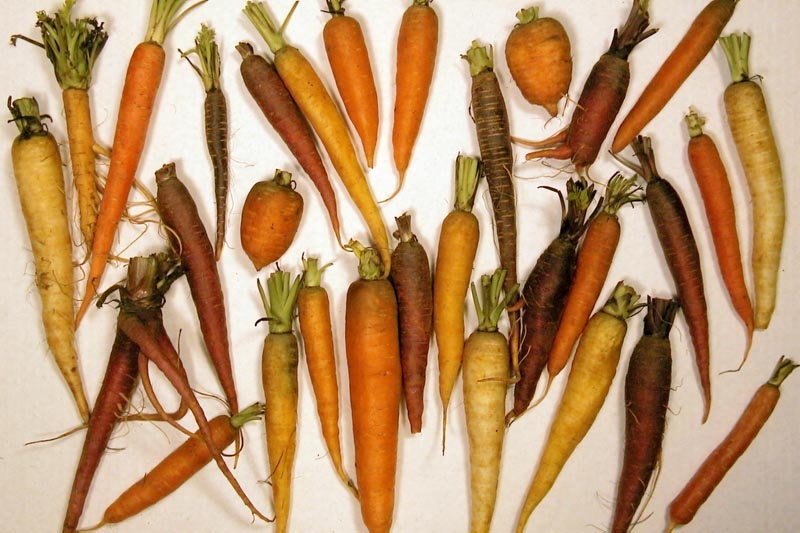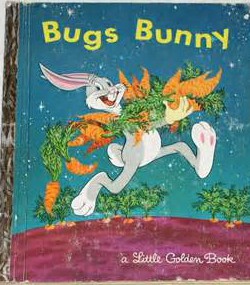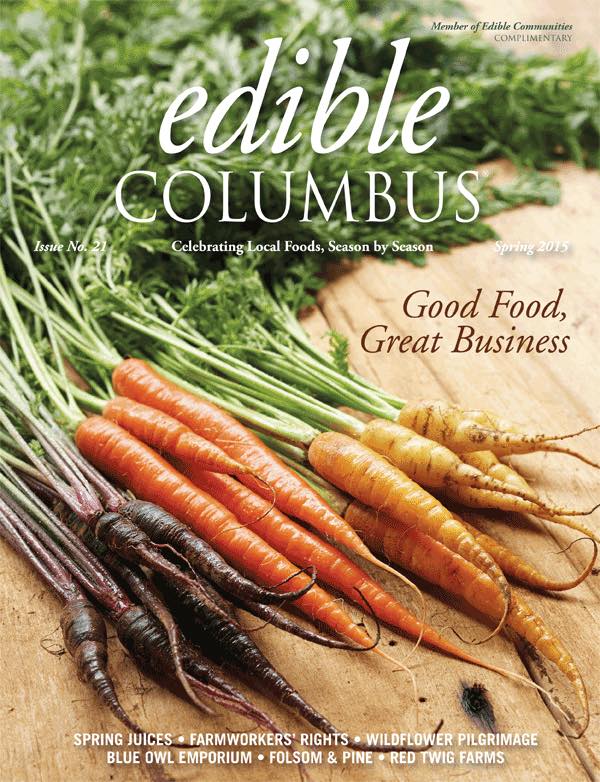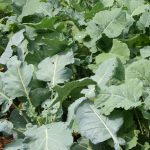by GardenLover | Apr 11, 2015 | Favorite Flora, Good eats

Photo Credit: World of Carrots Museum
By Debra Knapke
Bugs Bunny did for carrots what Popeye the Sailor did for Spinach. How many lip-locked, head-swelling children were coerced into eating their carrots by mothers cooing, “…but Bugs Bunny eats HIS carrots.” Mel Blanc (the voice of Bugs Bunny of Looney tunes fame)
How many lip-locked, head-swelling children were coerced into eating their carrots by mothers cooing, “…but Bugs Bunny eats HIS carrots.” Mel Blanc (the voice of Bugs Bunny of Looney tunes fame)
Carrots are one of my favorite snacks, especially ones just harvested from the garden. I am envious of Michael’s success with his carrots – bragging rights, indeed – as the past few years have not been the best carrot-growing years for me. But, this is the year. I have: five varieties I’ve not tried, good compost, a dedicated spot and I will be planting in late May/early June to avoid the carrot maggot. Well, that’s the plan.
I decided to go back to basics and grow all orange varieties this year, except for ‘Atomic Red’. I am intrigued with the health claims for this lycopene-loaded carrot and its reputed deep, deep red color. The others are all faster maturing, smaller varieties. ‘Parisienne’ and ‘Romeo’ are small round carrots while ‘Little Finger’ and ‘Babette’ have slender, cylindrical forms. Another goal this year is to do more pickling; ‘Little Finger’ and ‘Babette’ will be perfect for pint-sized jars.
As I looked for ways to increase my success with carrots, in my books and on the web, I stumbled upon a website in England that is dedicated to the glory of the carrot. John Stolarczyk, founder and curator of the World Carrot Museum has gathered an impressive body of information that is useful and a bit quirky. I’m thinking I need to make a “flutenveg”, a variation of a set of pan pipes. I’m not sure of the tone quality it produces, but who cares? Laughter will cover any off-pitch note.
If you want a more comprehensive list of carrot cultivars by color,  take a look at my picks in the “What to Plant” section in the latest Edible Columbus. There is a carrot for everyone’s taste. There is still time to order seeds or visit your favorite garden center to pick up a few varieties. Below are a few quick notes that will help you be a successful carrot grower.
take a look at my picks in the “What to Plant” section in the latest Edible Columbus. There is a carrot for everyone’s taste. There is still time to order seeds or visit your favorite garden center to pick up a few varieties. Below are a few quick notes that will help you be a successful carrot grower.
- Carrot seeds are usually directly sown into the garden; the taproot is easily damaged if transplanted.
- Sow carrot seeds shallowly; consistent moisture is important for good germination.
- Longer roots need deeper, friable soil; if you have clay or rocky soils, choose shorter carrots.
- A potential pest is the rust fly maggot; plant at the very end of May or early July to avoid the first generation of egg-laying flies or use row covers to exclude the fly.
And, if carrots are not your ideal vegetable, here is another point-of-view from the incomparable Mae West:
I never worry about diets. The only carrots that interest me are the number you get in a diamond.
by GardenLover | Apr 8, 2015 | Special Topic
By Teresa Woodard
I really don’t need another hobby. Yes, my teenage kids are growing more independent, but I already have a full plate with gardening, chickens and pets. So, do I really need to take on beekeeping?
After Saturday’s beekeeping workshop, I’m convinced I should finally put to use our homemade bee box that’s sitting idle in the basement and purchase my first “nuc” or starter colony of bees. I learned beekeeping not only offers sweet honey rewards and promises of increased backyard garden pollination, but more importantly contributes to the local beekeeping community’s grassroots efforts to re-build the Midwest’s honeybee gene pool that was recently wiped out by varroa mites.
Did you know?
- Bee varieties: In the United States, there are three basic types of honeybees– Italian, Caucasian and Carniolan – and many variations of each as they adapt to local conditions.
- Southern vs. northern bees: Bees imported from southern states are not adapted to the Midwest and in turn are less apt to ward off troublesome mites. New beekeepers using local versus imported stock are much more likely to be successful.
- Drones: Drones, the male bees responsible for mating the queen bee, are in short supply, so a boost in drones numbers will help diversity honeybees’ gene pool.
- Queens: Queen honeybees mate just once in their lives, within weeks of emerging as an adult. On their maiden flight from the hive, they travel to mate with drones from another colony. They mate in mid-air, at about 20 feet above the ground, with seven to 15 drones. After mating, the drones die, and the queens return to the hive to lay eggs. Check out this interesting queen bee mating clip from the movie More Than Honey.[youtube https://www.youtube.com/watch?v=tR7Nts42sYo&w=560&h=315]
- Sex determination: A queen determines whether a particular egg is fertilized or not. Unfertilized eggs become drone honey bees, while fertilized eggs develop into female workers and queens.
- Swarms: At nearby Mockingbird Meadows, this honey and herb farm takes another approach. It allows its “feral” hives to swarm and also collects swarms from the community as a way to increase bee population.
Perhaps, my fellow bloggers have the right idea. Michael Leach offers his backyard to a neighbor beekeeper who keeps a hive behind his shed (see Oct. 2013 blog post on beekeeping ). And of course, Deb Knapke creates a safe, chemical-free haven for various pollinators and offers a season-long smorgasbord of their favorite flowers for foraging.
To learn more about beekeeping, check out beekeeping schools offered this spring by state beekeeping associations.
“If bees were to disappear from the globe, mankind would only have four years left to live.” — Albert Einstein
by GardenLover | Apr 1, 2015 | Special Topic
Simple Techniques to Reap Early Rewards
In my part of the Midwest, planting potatoes, peas and other cold-tolerant vegetables on St. Patrick’s Day is a garden tradition best kept in the breaking. Usually, it’s way too cold and wet.
So imagine my delight from digging potatoes and snipping a few tiny, tender collard and Asian greens on St. Patrick’s Day.
Boasting boosted agriculture
Some of you probably have even better harvests to brag about, after all, bragging is a somewhat shameful but timeless element of gardening. I suspect one reason agriculture caught on with our paleo-forefathers may have been one-upping each other on the size and flavor of prehistoric veggies. Flowers might have factored in as well, assuming our paleo-foremothers were as delighted with a bunch of blossoms in a man’s hands as many women are today.
Times change but not bragging rights. Producing the first tomato of the summer prompts incredible antics by some growers: choosing Early Girl or other can’t-wait-to-set-fruit varieties, coddling seedlings under grow lights, using mini greenhouses, and muttering mystical chants passed down from those first gardeners.
Enough about chest thumping. In the case of my potatoes, they aren’t the first of the season but the last of last season.
Secrets of success
My approach is a mix of old and new. Grandpa Leach once described to me the vegetable pit on the hard-scrabble farm of his childhood. My memory isn’t clear on details, but the pit was something of an outdoor root cellar lined with straw. The vegetables were placed in layers and covered with straw and soil. Supposedly root veggies, cabbages, potatoes and some fruit stayed fresh in the cold, moist conditions. They dug food throughout the winter. (No small thing, considering the tales I heard of about walking to school through 4-feet deep snow from November through March.)
Being lazy, I skipped the excavation. I even skipped digging potatoes, which don’t keep very long in my cellar. Instead, mulch was piled thickly over the potato bed. A lot more mulch was needed this bitter winter — about half the potatoes dug St. Patrick’s Day were partly to totally mushy. The rest, however, are unscathed and delicious, as only home-grown Yukon Golds can be.
The collard greens were sown Aug. 15 and grew to micro-green size before serious cold weather arrived in early November. Immediately after seed planting, I secured floating row covers over the beds.
Protection service
Designed to thwart insects from accessing the greens, the row covers serve as something of a windbreak. I discovered this by accident a few years ago when I was too lazy to remove it after winter arrived. Even in the horrid winter of 2014, I picked a few leaves of collards and kale on St. Patrick’s Day. In milder winters, various greens can be picked all season, though growth slows to zip from mid-November to mid-February.
Can you top this?
Besides greens, I discovered the carrots, planted in late summer (tag is missing), came through just fine under the row cover. A couple dug on March 30 were sweet and crisp.
OK, that’s my story. What’s yours? Surely someone can top all this.
Inspiring ideas
For more inspiration about year-round harvests check out www.fourseasonfarm.com, site of Eliot Coleman’s Maine vegetable farm that uses no heated greenhouses.
by GardenLover | Mar 12, 2015 | Favorite Flora
Let Them Eat Tomatoes!
By Debra Knapke
I’ve seen reports that we are losing selections of our heirloom vegetables, but I can’t imagine trying to sort through more tomato options than we have right now. With thoughts of downsizing and focusing on tomatoes we have grown and enjoyed, I choose seven cultivars of tasty tomatoes. I ordered seeds and sat back to wait for them to arrive.
Then I was on Ron Wilson’s Saturday morning radio show, and he just had to introduce me to several tomato cultivars and a new catalog. There are now 12 cultivars of tomatoes – six seeds for each – sitting in the greenhouse taking advantage of this sunny day. If they all germinate there will be 72 plants… who wants tomato plants?
Here is my list with some comments.
Cherry:
- ‘Blue Berries’ from Wild Boar Farms – Brad Gates is offering this tomato that is packed with anthocyanins; can’t wait to try this purple cherry.
- ‘Black Vernissage’ – a gift package from Baker Creek Heirlooms; another dark tomato from the Ukraine… we are going to be so healthy.
- ‘Litt’l Bites’ – a determinate container cherry from Renee’s Garden that will please my granddaughters
Yellow:
- ‘Gold Medal’ – an old standby for us; big and juicy, more sweet than tart.
Orange:
- ‘Kellogg’s Breakfast’ – Ron insisted that this is one of the best tomatoes ever; not sure I will eat it for breakfast.
- ‘Mandarin Cross’ – this is a hybrid that just said: try me.
Red:
- ‘Moneymaker’ – Botanical Interests (and other seed companies) offers this red slicer tomato that is an old English heirloom. I like heirlooms…
- ‘Crimson Carmello’ – I jumped across the Channel to try this French hybrid heirloom. Our tomato choices are quite international.
- ‘Red Brandywine’ – one of our favorites; need I say more?
Black:
- ‘Black Krim’ – another favorite that we plant year after year.
- ‘Cherokee Purple’ – not planting this just might be grounds for divorce (just kidding; I think)
- ‘Indigo Apple’ – another Wild Boar Farms introduction that beckoned from the pages of the Baker Creek catalog.
Last note: this isn’t our longest list of tomatoes. One year I started 16 kinds of tomatoes including a white cultivar and a green cultivar. Please observe that neither of those colors are represented in the above list.
by GardenLover | Mar 6, 2015 | Favorite Flora

Diane witchhazel (Hamamelis xintermedia ‘Diane’ a hybrid of Hamamelis japonica and H. mollis)
By Debra Knapke
Depending on the weather, the hybrid witchhazels may be flowering right now. This plant blooms in winter after a brief warming period which means they can bloom anytime from mid-January to March. Watch for signs of swelling buds. And, make sure you go out and breathe in the spicy scent, once the flowers have fully opened. A wonderful way to battle the winter blues! If you can’t wait for the blooms in the garden, cut several branches and bring them inside to force blooms.
 How many lip-locked, head-swelling children were coerced into eating their carrots by mothers cooing, “…but Bugs Bunny eats HIS carrots.” Mel Blanc (the voice of Bugs Bunny of Looney tunes fame)
How many lip-locked, head-swelling children were coerced into eating their carrots by mothers cooing, “…but Bugs Bunny eats HIS carrots.” Mel Blanc (the voice of Bugs Bunny of Looney tunes fame) take a look at my picks in the “What to Plant” section in the latest Edible Columbus. There is a carrot for everyone’s taste. There is still time to order seeds or visit your favorite garden center to pick up a few varieties. Below are a few quick notes that will help you be a successful carrot grower.
take a look at my picks in the “What to Plant” section in the latest Edible Columbus. There is a carrot for everyone’s taste. There is still time to order seeds or visit your favorite garden center to pick up a few varieties. Below are a few quick notes that will help you be a successful carrot grower.


